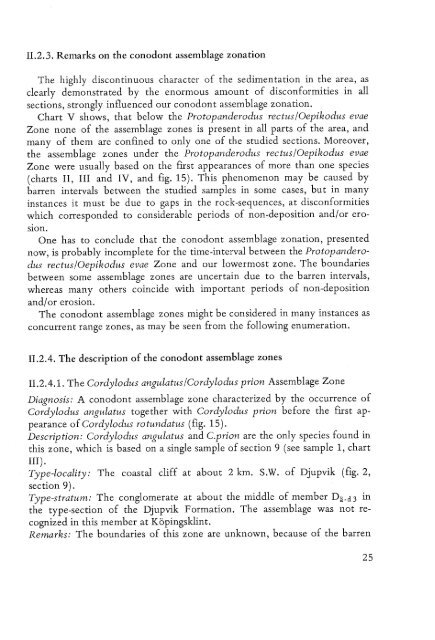UTRECHT MICROPALEONTOLOGICAL BUllETINS
UTRECHT MICROPALEONTOLOGICAL BUllETINS
UTRECHT MICROPALEONTOLOGICAL BUllETINS
You also want an ePaper? Increase the reach of your titles
YUMPU automatically turns print PDFs into web optimized ePapers that Google loves.
The highly discontinuous character of the sedimentation in the area, as<br />
clearly demonstrated by the enormous amount of disconformities in all<br />
sections, strongly influenced our conodont assemblage zonation.<br />
Chart V shows, that below the Protopanderodus rectus/Oepikodus evae<br />
Zone none of the assemblage zones is present in all parts of the area, and<br />
many of them are confined to only one of the studied sections. Moreover,<br />
the assemblage zones under the Protopanderodus rectus/Oepikodus evae<br />
Zone were usually based on the first appearances of more than one species<br />
(charts II, III and IV, and fig. 15). This phenomenon may be caused by<br />
barren intervals between the studied samples in some cases, but in many<br />
instances it must be due to gaps in the rock-sequences, at disconformities<br />
which corresponded to considerable periods of non-deposition and/or erosion.<br />
One has to conclude that the conodont assemblage zonation, presented<br />
now, is probably incomplete for the time-interval between the Protopanderodus<br />
rectus/Oepikodus evae Zone and our lowermost zone. The boundaries<br />
between some assemblage zones are uncertain due to the barren intervals,<br />
whereas many others coincide with important periods of non-deposition<br />
and/ or erosion.<br />
The conodont assemblage zones might be considered in many instances as<br />
concurrent range zones, as may be seen from the following enumeration.<br />
II.2A.I. The Cordylodus angulatus/Cordylodus prion Assemblage Zone<br />
Diagnosis: A conodont assemblage zone characterized by the occurrence of<br />
Cordylodus angulatus together with Cordylodus prion before the first appearance<br />
of Cordylodus rotundatus (fig. 15).<br />
Description: Cordylodus angulatus and C.prion are the only species found in<br />
this zone, which is based on a single sample of section 9 (see sample 1, chart<br />
III).<br />
Type-locality: The coastal cliff at about 2 km. S.W. of Djupvik (fig. 2,<br />
section 9).<br />
Type-stratum: The conglomerate at about the middle of member Da-d3 in<br />
the type-section of the Djupvik Formation. The assemblage was not recognized<br />
in this member at Kopingsklint.<br />
Remarks: The boundaries of this zone are unknown, because of the barren
















